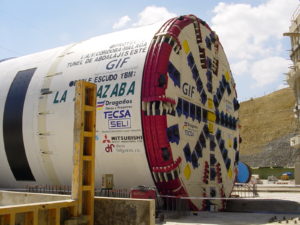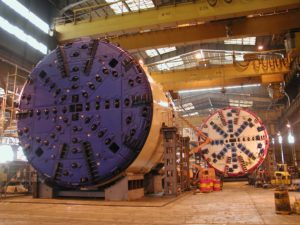![65 Years of Innovation and Experience [default]](https://www.robbinstbm.com/wp-content/uploads/2017/04/Side-Bar-Blue-Blocks_70-Years.jpg)
A Solution for Every Condition: Search our Project Database
Project Map
FEATURED PRODUCT: CROSSOVER MACHINES
Our History
A Legacy of Innovation
Information 24/7
News & Media
Insights in the Industry:
Read the Robbins Blog
 Spain’s high-speed rail network, known as AVE, involves links between the major cities Cordoba, Madrid, Seville, and Malaga. The twin 7.1 km (4.4 mile) long Abdalajis tunnels are part of this rail network and they will contribute to Spain’s overall goal to keep all major cities within four hours travel time from Madrid.
Spain’s high-speed rail network, known as AVE, involves links between the major cities Cordoba, Madrid, Seville, and Malaga. The twin 7.1 km (4.4 mile) long Abdalajis tunnels are part of this rail network and they will contribute to Spain’s overall goal to keep all major cities within four hours travel time from Madrid.
In 2001, the project owner Gestor de Infraestructuras Ferroviarias (GIF) awarded construction contracts separately for each tunnel. The east tunnel was awarded to a Dragados-led consortium called UTE Abdalajis, comprising Dragados, TECSA, SELI, and Jaeger. The west tunnel was awarded to a consortium called UTE Abdalajis Oueste (SACYR S.A., Somague-Engenharia). The two groups shared the main portal site and used nearly identical tunnel boring machines.
Both consortiums chose Double Shield TBMs designed by Robbins for Mitsubishi Heavy Industries. The machines were initially built in Spain by Duro Felguera. They were then assembled onsite with both Robbins and Mitsubishi technicians supervising the assembly.
The Abdalajis tunnels pass through a variety of rock types, including dolomitic limestone, quartzite, conglomerates, and sandstone. In the deepest part of the tunnels the strata is heavily fractured and karstic conditions in the limestone may harbor considerable amounts of water. The entire span of each tunnel contains more than twenty fractured and faulted areas.
The TBMs featured sixty-four 17 inch (432mm) back-loading cutters and could generate a cutterhead thrust of 82,500 kN ( 18,546,734 lb). The Robbins Double Shield design generated a maximum cutterhead torque of 18,700,000 N-m (13,792 lb-ft). Both machines came with probe drills and foam application systems for face conditioning.

Excavation of the eastern tunnel began in November 2003. The custom design of the TBM allowed it to bore through brittle and heavily fractured rock efficiently. The TBM’s production rates along the first 1,590 m (5,217 ft) were very good with advance rates as high as 34 m (112 ft) per day.
In the middle of the tunnel bore, methane intrusions began to increase. Roughly 800 m (2,625 ft) of fractured clay with methane leaks forced stoppages to ventilate the tunnel. Despite these conditions the TBM kept a constant advance rate and encountered more stable limestone at the end of the tunnel before holing through in January 2006.
The west tunnel machine also began boring in November with similar broken ground and methane gas problems. Similar to the east tunnel TBM, the machine kept constant advance rates despite the unfavorable conditions. The TBM also encountered more stable limestone in the final meters of the tunnel. The west tunnel TBM finished roughly 2.5 months after the hole through in the east tunnel.

 Close
Close